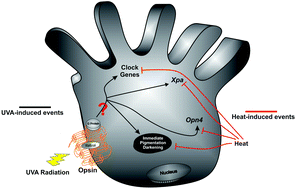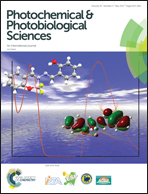Heat shock antagonizes UVA-induced responses in murine melanocytes and melanoma cells: an unexpected interaction†
Abstract
The skin is under the influence of oscillatory factors such as light and temperature. This organ possesses a local system that controls several aspects in a time-dependent manner; moreover, the skin has a well-known set of opsins whose function is still unknown. We demonstrate that heat shock reduces Opn2 expression in normal Melan-a melanocytes, while the opposite effect is found in malignant B16-F10 cells. In both cell lines, UVA radiation increases the expression of Opn4 and melanin content. Clock genes and Xpa, a DNA repair gene, of malignant melanocytes are more responsive to UVA radiation when compared to normal cells. Most UVA-induced effects are antagonized by heat shock, a phenomenon shown for the first time. Based on our data, the heat produced during UV experiments should be carefully monitored since temperature represents, according to our results, an important confounding factor, and therefore it should, when possible, be dissociated from UV radiation. The responses displayed by murine melanoma cells, if proven to also take place in human melanoma, may represent an important step in cancer development and progression.



 Please wait while we load your content...
Please wait while we load your content...